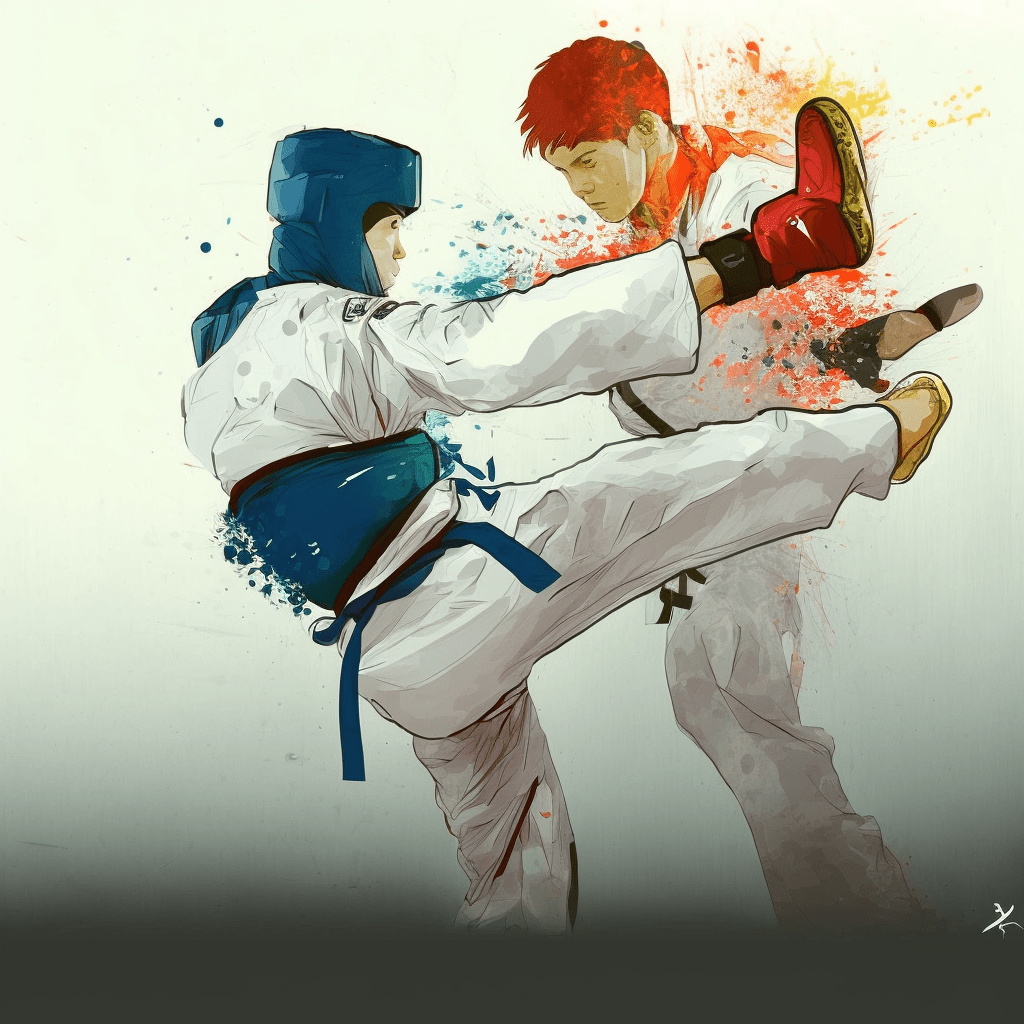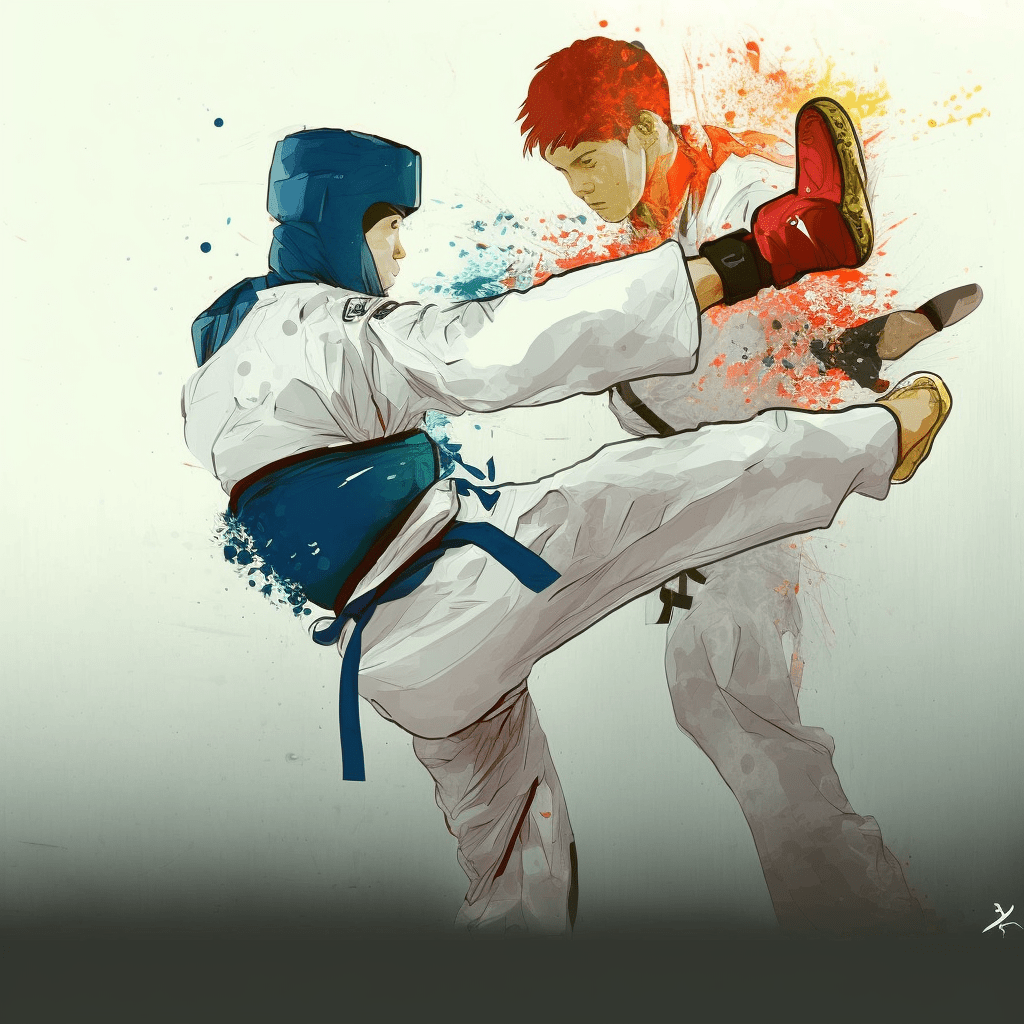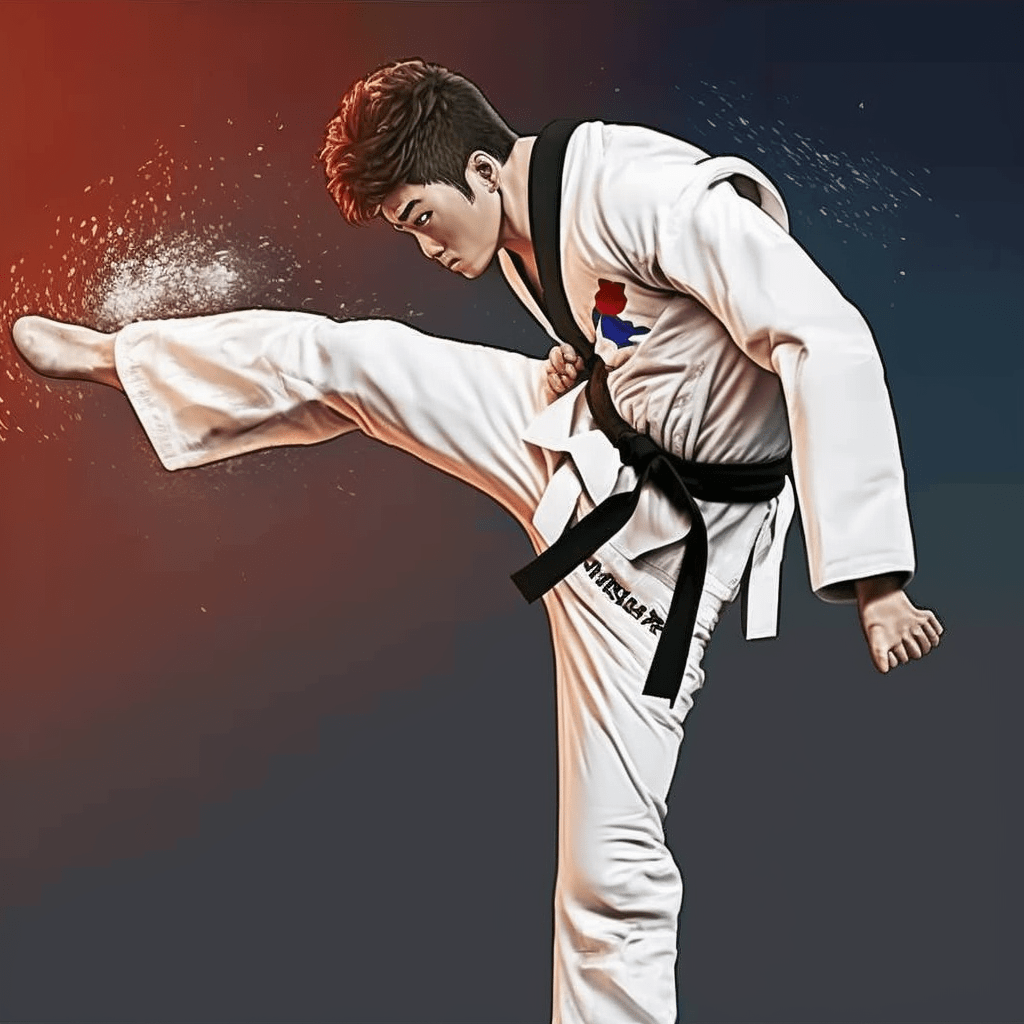What is the Difference Between Karate and Taekwondo?
Karate and taekwondo are two martial arts with a long and storied history. From their origins to techniques and applications, these two martial arts offer practitioners a variety of benefits.
Karate and taekwondo both share many similarities, though they also have their own distinct differences. Physical and mental benefits can be gained from practicing either martial art.
Whether one is looking to learn self-defense or simply to stay in shape, karate and taekwondo are two martial arts that can provide a unique and rewarding experience.

History
When it comes to martial arts, Karate and Taekwondo have a long and distinguished history. Karate originated in Okinawa, Japan in the 1400s as a form of unarmed combat, while Taekwondo was developed in Korea in the 1940s, drawing from ancient Korean martial arts and Japanese Karate. Karate was brought to mainland Japan in the early 20th century and has since become a popular form of self-defense.
As far as techniques go, Karate relies heavily on hand strikes, blocks, and kicks, while Taekwondo emphasizes kicking and agility. Furthermore, Karate has forms and kata, which are prearranged sets of movements that are intended to teach a practitioner how to use their techniques effectively. Taekwondo, however, has sparring and poomsae, which are prearranged forms of self-defense.
Karate can be divided into two main styles, Shotokan and Goju-ryu. The former emphasizes linear, powerful movements, while the latter is more circular and relies more on internal power. Taekwondo is divided into several different styles, such as Tae Kwon Do, Chung Do Kwan, and Hwa Rang Do.
Karate and Taekwondo can be used for both self-defense and sport. In self-defense, practitioners must be aware of their surroundings and use their techniques effectively to protect themselves from harm. In sport, practitioners use their techniques to compete against one another in competitions. Practicing karate and taekwondo can provide many benefits, both physical and mental. Physically, practitioners can improve their strength, flexibility, and coordination. Mentally, they can learn discipline, focus, and self-confidence. These benefits can be enjoyed by practitioners of all ages and skill levels.
In conclusion, Karate and Taekwondo are two martial arts with a long and storied history. From their origins to their techniques and applications, these two martial arts offer practitioners a variety of benefits. Whether one is looking to learn self-defense or simply to stay in shape, karate and taekwondo are unique and rewarding experiences.
Origin
When compared, Karate has a more structured approach, with an emphasis on strikes and blocks, while Taekwondo is more open and flexible, focusing more on kicks and movements. Karate has forms and kata, which are prearranged sets of movements that teach practitioners how to use their techniques effectively. Taekwondo also has sparring and poomsae, which are prearranged forms of self-defense.
Karate can be divided into two main styles: Shotokan and Goju-ryu. Shotokan focuses more on linear, powerful movements, while Goju-ryu emphasizes circular techniques and internal power.
Taekwondo, on the other hand, is divided into several different styles, such as Tae Kwon Do, Chung Do Kwan, and Hwa Rang Do.
Karate and Taekwondo can be used for a variety of purposes, both in self-defense and as a sport. Practitioners must be aware of their surroundings and use their techniques effectively to protect themselves from harm. In sport, practitioners use their techniques to compete against one another in competitions.
Development
When it comes to martial arts, Karate and Taekwondo are two distinct styles of combat that have been captivating audiences for centuries. Karate originated in Okinawa, Japan and has been developed over hundreds of years, incorporating elements from various local cultures. Taekwondo, on the other hand, was established in the 1950s by a group of Korean martial arts masters.
Karate is a more structured style of martial arts, emphasizing strikes and blocks. This style of combat requires discipline, self-defense and physical conditioning. Taekwondo, however, is much more open and flexible, focusing mainly on kicks and movements.
Karate can be divided into two main styles: Shotokan and Goju-ryu. Shotokan focuses on powerful linear strikes, while Goju-ryu focuses on circular techniques and internal power. Taekwondo, likewise, is divided into several different styles such as Tae Kwon Do, Chung Do Kwan and Hwa Rang Do.
Karate and Taekwondo can be used for a multitude of purposes. They can be used in self-defense, for sport or for physical and mental health benefits. Practitioners must be aware of their surroundings and use their techniques efficiently in order to protect themselves. In sport, practitioners compete against one another with their techniques. Additionally, these martial arts provide a multitude of physical and mental benefits such as increased strength, flexibility, coordination, discipline, focus, and self-confidence.
Style
Karate is a striking art that focuses on powerful and precise punches and kicks, while Taekwondo is a kicking art which emphasizes powerful, spinning and jumping kicks. Karate techniques are mainly hand techniques, while Taekwondo techniques are mainly kicking techniques.
Karate stances are generally more compact and rooted to the ground, while Taekwondo stances are more upright and open. Karate tends to have more linear movements, while Taekwondo has more circular movements.
Karate has a slower, more deliberate pace, while Taekwondo has a faster, more explosive pace. Karate focuses more on self-defense, while Taekwondo focuses more on sport and competition.

Stance
This understanding the stance between two parties is the basis of any successful relationship. It is the desired outcome for both involved parties to be satisfied with the results; to benefit from the stance, both parties must come to a consensus.
While taking this stance can be beneficial, it is important to recognize the potential risks involved. To ensure a successful outcome from the stance, both parties need to be willing to commit to their responsibilities and commitments.
It is essential to recognize and respect the stance of each party in order to foster a positive and beneficial relationship. This requires a commitment from both parties to work together and come to an agreement that will meet the needs of all.
Techniques
We often hear about Karate and Taekwondo, two martial arts that have a long history and are popular in many countries. While both of these martial arts have some similarities, there are some distinct differences between them.
One way to distinguish between Karate and Taekwondo is through the techniques they use. Karate has a wide range of techniques and strategies that focus on striking, blocks, and evasive maneuvers.
Taekwondo, on the other hand, emphasizes powerful kicks and strikes with the feet and hands. Karate tends to have more of a focus on hand techniques, while Taekwondo has more of a focus on foot techniques.
However, both martial arts incorporate balance and coordination into their techniques, and offer a variety of techniques that can be adapted to different situations.
In addition, both Karate and Taekwondo can be practiced for self-defense, competition, and exercise.
Popularity
When it comes to martial arts, few are as popular as karate and taekwondo. Karate has been around for centuries and is considered one of the most famous martial arts in the world. It has been featured in movies, TV shows, and books, helping to increase its popularity.
On the other hand, taekwondo is a relatively newer martial art and is not as well-known as karate. Although it has gained more attention in recent years, it still lags behind karate in terms of worldwide recognition. Karate is more widely practiced than taekwondo in many countries, due to its long history and global reputation.
Taekwondo has seen a rise in popularity in certain countries, but it still cannot match karate in terms of worldwide recognition. Both martial arts offer a variety of techniques and strategies that make them unique from one another.
Global Reach
Karate is most popular in the United States, Japan, and China. Taekwondo is more widely practiced in South Korea and other parts of Southeast Asia.
Both martial arts are available to be practiced in local dojos and training centers around the world. There are international competitions and events held regularly for both Karate and Taekwondo.
Practitioners come in all shapes and sizes, with all levels of athleticism. Some students of the martial arts are drawn to the raw physicality and competitive nature of the sport, while others find the spiritual and mental benefits of the practice equally appealing.
Some train to become professional athletes, while others are content to practice and compete casually. Regardless of the level of commitment, both Karate and Taekwondo offer a unique opportunity to learn and grow.

Practitioners
In the world of martial arts, Karate and Taekwondo are two of the most popular styles. Karate has a rich history, while Taekwondo is a relatively more recent martial art. However, both have achieved global recognition, with millions of practitioners across the world. Karate’s popularity has been boosted by its appearances in movies, TV shows, and books, while Taekwondo has been given an extra boost due to its inclusion in the Olympic Games.
Karate is especially popular in Japan, China, and the United States, while Taekwondo is more widely practiced in South Korea and other parts of Southeast Asia. Both martial arts are available to be practiced in local dojos and training centers around the world, with international competitions and events for both Karate and Taekwondo held regularly.
When it comes to practitioners of these martial arts, there are some distinct differences. For example, Karate practitioners typically focus on short, explosive strikes, while Taekwondo practitioners may focus on a variety of kicks and hand techniques. Furthermore, Karate practitioners often train in traditional katas, while Taekwondo practitioners may include more sparring and self-defense techniques.
Additionally, Karate is generally more popular among adults and children, while Taekwondo is more popular among teens and young adults.
Examples
We often think of Karate and Taekwondo as similar martial arts, but there are actually many differences between the two. Karate is known for its short, explosive strikes, while Taekwondo relies more heavily on kicks and hand techniques. Also, Karate practitioners train in traditional katas, while Taekwondo practitioners focus more on sparring and self-defense techniques.
The way the two martial arts approach striking, blocking, and kicking is also quite different. Karate practitioners use their hands and feet to deliver powerful strikes, while Taekwondo practitioners focus on using their feet to kick. In addition, Karate practitioners use blocking techniques to deflect an opponent’s attack, while Taekwondo practitioners use evasive movement to avoid attack.
There are distinct differences in their stances and belts. Karate practitioners typically use a forward stance, while Taekwondo practitioners use a light and mobile stance. And while Karate practitioners have a belt system based on their level of skill, Taekwondo practitioners have a belt system based on their age.
Karate practitioners rely heavily on footwork and balance, while Taekwondo practitioners focus more on agility and speed. There are also differences between Karate and Taekwondo in terms of their scoring systems. Karate practitioners score points for accuracy and power, while Taekwondo practitioners score points for technique, power, and control.
Traditional Karate
Karate is a martial art that originates from Okinawa, Japan, and focuses on striking techniques such as punches, kicks, elbow and knee strikes, as well as open-handed techniques like palm-heel strikes and knife-hands. It is a striking-based art that relies on body mechanics, rather than brute strength, to generate power and utilizes a number of kata or pre-arranged forms to practice and improve the techniques.
Karate also has a strong emphasis on self-defense and the development of character and discipline. It is often seen as a more traditional and spiritual approach to martial arts compared to other forms.
Taekwondo
Originating in the 1940s, Taekwondo is a Korean martial art and sport characterized by fast and powerful kicking techniques, as well as blocks, punches, and open-hand strikes. The art also emphasizes on developing mental strength, physical fitness, and self-defense.
To show their rank and progress, practitioners of Taekwondo wear a traditional white uniform and a belt. Additionally, Taekwondo emphasizes physical conditioning, self-defense, and discipline.
But what are the benefits of this rigorous art?
Benefits
When it comes to the benefits of practicing Karate and Taekwondo, both martial arts offer physical, mental, and emotional benefits. Physically, both martial arts are great for building strength, flexibility, and balance.
Mentally, both martial arts help to build focus, concentration, and self-confidence. They also provide emotional benefits, such as increased self-control, self-awareness, and inner peace.
Finally, overall benefits of practicing Karate and Taekwondo include improved physical health, stress relief, and an overall sense of well-being.
We can see then that practicing Karate and Taekwondo offer a wide range of benefits. While they may seem similar, they each offer unique benefits that make them both worthwhile to learn.
Physical Fitness
In the world of martial arts, two of the most popular and widely practiced disciplines are Karate and Taekwondo. While both offer physical, mental and emotional benefits, what really sets them apart? Karate is a Japanese martial art that emphasizes physical fitness and the development of muscular strength, speed, and flexibility. It also focuses on kata, a series of set movements to test and improve physical and mental strength.
Moreover, Karate focuses more on striking and blocking techniques while Taekwondo emphasizes kicking. In addition, Karate requires more power behind techniques while Taekwondo requires more precision and control.
Finally, Karate also requires more mental strength and discipline. All of these factors distinguish Karate from Taekwondo and make for a unique martial art experience.
Mental Discipline
We often hear of Karate and Taekwondo as two of the most popular martial arts in the world, each offering its own unique benefits. It’s important to understand the differences between the two in order to make an informed decision about which is right for you.
Karate practitioners tend to have a more traditional approach, focusing on kata and forms, while taekwondo practitioners prefer a more modern approach, emphasizing sparring and physical conditioning. Karate emphasizes fundamentals and technique, while taekwondo emphasizes speed and power.
Karate is more focused on control and precision, while taekwondo is more focused on power and speed. Mental strength is essential in both karate and taekwondo, as both martial arts require practitioners to stay focused and disciplined. Respect for opponents and teachers is an important part of both karate and taekwondo.
Conclusion
Each offers its own unique benefits and philosophies, and it takes a careful examination of both to determine which is best for an individual. Karate and Taekwondo may appear similar on the surface, but there are many differences between them.
Karate is a traditional martial art that emphasizes fundamentals and technique. It is focused on control and precision, and practitioners strive for a combination of physical and mental strength. On the other hand, Taekwondo is a modern martial art that focuses on speed and power. While physical strength is important, mental strength is just as necessary in both martial arts.
In addition to the different philosophies behind Karate and Taekwondo, there are also unique forms of competition for each. Karate competitions usually involve kata and forms, while Taekwondo competitions typically involve sparring and physical conditioning.
Both Karate and Taekwondo are excellent ways to develop strength, discipline, and self-defense skills. Respect for opponents and teachers is an important part of both martial arts, and practitioners must be dedicated to master the techniques and movements.
FAQs
What is the Difference Between Karate and Taekwondo?
When it comes to techniques used in both martial arts, each is distinct. Karate focuses on control and precision, while Taekwondo is fast-paced and powerful. In addition, the stances and postures of each martial art are different. Karate practitioners maintain a low stance, while Taekwondo practitioners stand tall and upright.
The outcome-based differences between Karate and Taekwondo are also noteworthy. Karate competitions usually involve kata and forms, while Taekwondo competitions typically involve sparring and physical conditioning.
In addition to the different philosophies and techniques, there are also unique benefits of practicing either martial art. Practitioners of Karate and Taekwondo develop strength, discipline, and self-defense skills.
What Stance is Used in Karate?
Karate is a traditional martial art that has been practiced for centuries, and its stance is an integral part of the art form. The stance used in karate is a low and stable one, with the feet positioned shoulder-width apart. The body is kept in a forward-facing position, with a slight lean forward. The arms are kept away from the body, allowing for quick, precise movements.
This stance allows for maximum power when striking, as well as mobility and speed. Not only does this stance give karate practitioners the necessary tools for effective self-defense, but it also defines the look and feel of the martial art, being maintained throughout all karate techniques.
With this stance, karate practitioners can practice safely, while also executing powerful techniques with precision.
What Techniques are Used in Taekwondo?
Taekwondo is an exciting martial art that has been practiced for centuries. It is known for its emphasis on kicks and its powerful focus on striking techniques.
A practitioner of Taekwondo will learn to execute a variety of punches, strikes, elbows, and blocks. To perfect their form and technique, Taekwondo practitioners also practice joint locks and throws and engage in kicking drills and sparring.
Additionally, meditation and breathing exercises are used for relaxation and to create a sense of peace and balance. When it comes to mastering this martial art, it is clear that there is a lot to learn. But with a combination of practice and dedication, Taekwondo practitioners of all levels can achieve their goals.
Is Karate or Taekwondo More Popular?
When it comes to martial arts, one of the most debated topics is whether karate or taekwondo is the more popular option. To many, this question can be difficult to answer, as both martial arts have been practiced for centuries and have gathered an abundance of fans and followers around the globe.
Karate and taekwondo are both popular martial arts, however, the prevalence of each varies from region to region. For example, karate is highly popular throughout Asia, while taekwondo has gained a lot of attention in Europe and North America. In addition to geographical differences, popularity of these martial arts also varies by age and gender. Generally, karate is more popular among older generations while younger generations tend to prefer taekwondo. Women and girls often opt for taekwondo, while men and boys often choose karate.
The popularity of both martial arts has been greatly impacted by martial arts movies, particularly in recent years. Many of the most popular and successful martial arts movies of all time have featured karate or taekwondo, and this has caused interest in these martial arts to skyrocket.
In addition, the rise of mixed martial arts has often led to an increase in the popularity of both karate and taekwondo.
Finally, there are a number of other factors that may influence the popularity of karate and taekwondo in the future. Societal trends, access to resources, and media attention are all likely to play a role in determining the future of martial arts.
Ultimately, determining which martial art is more popular is a difficult task. While karate and taekwondo have both been practiced for centuries, their popularity varies around the world and among different ages and genders. The impact of martial arts movies, the rise of mixed martial arts, and other factors will all continue to shape the popularity of these two martial arts.
v. What are the Benefits of Practicing Karate or Taekwondo?
In recent years, martial arts have become increasingly popular, with karate and taekwondo being two of the most studied and respected styles. While the two martial arts have many similarities, they also have notable differences. For those looking to begin martial arts training, understanding the benefits of karate and taekwondo is the first step.
Karate and taekwondo offer a host of physical benefits, including improved physical fitness, strength, and flexibility. Regular practice can also help to improve coordination and balance, as well as increase mental discipline and concentration.
Additionally, both martial arts can be a great way to relieve stress and relax. Finally, karate and taekwondo can help to build confidence, as they are both designed to help practitioners defend themselves if needed.
In addition to their physical benefits, karate and taekwondo both offer mental and emotional benefits as well. Practicing martial arts can help to sharpen focus, foster discipline, and help practitioners to identify and control their emotions.
Additionally, martial arts can help to build self-confidence and self-esteem. Overall, karate and taekwondo offer a number of physical, mental, and emotional benefits. For those looking to get into martial arts, understanding the differences between karate and taekwondo can be a great way to determine which style is the best fit.

